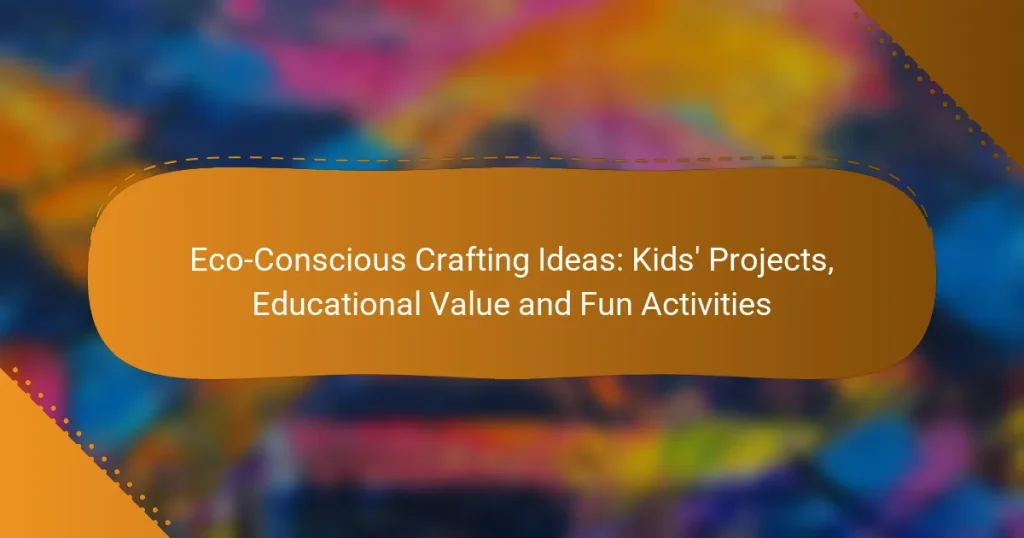Eco-conscious crafting ideas for kids offer a creative way to engage young minds while promoting sustainability. By using recycled materials and safe, non-toxic supplies, these projects not only inspire creativity but also instill a sense of environmental responsibility. Through fun and educational activities, children learn the value of reusing resources and the positive impact they can have on the planet.

What are eco-conscious crafting ideas for kids?
Eco-conscious crafting ideas for kids focus on using sustainable materials and practices to create fun and educational projects. These activities not only foster creativity but also teach children the importance of recycling and environmental stewardship.
Recycled paper crafts
Recycled paper crafts involve using old newspapers, magazines, or scrap paper to create new items. Kids can make greeting cards, paper mâché sculptures, or decorative collages, turning waste into art. This practice encourages creativity while reducing paper waste.
To start, gather various types of paper and scissors. Kids can tear or cut the paper into shapes, then glue them onto a base. Consider using eco-friendly adhesives to keep the project sustainable.
Upcycled fabric projects
Upcycled fabric projects repurpose old clothing or fabric scraps into new creations. Children can sew tote bags, patchwork quilts, or stuffed animals, giving new life to items that might otherwise be discarded. This not only reduces textile waste but also teaches valuable sewing skills.
Begin by collecting unwanted fabrics and discussing color combinations. Simple sewing techniques, such as straight stitching or hand sewing, can be taught to kids, making the process both educational and enjoyable.
Natural dyeing techniques
Natural dyeing techniques use plant-based materials to color fabrics or paper, providing a hands-on lesson in chemistry and nature. Common sources for dyes include beetroot for red, turmeric for yellow, and spinach for green. This method is safe and non-toxic, making it suitable for children.
To dye fabric, boil the plant materials in water, strain the liquid, and soak the fabric in the dye bath. Kids can experiment with different materials and soaking times to see how colors vary, enhancing their understanding of natural processes.
DIY bird feeders from bottles
Creating DIY bird feeders from plastic bottles is a fun way to engage kids with nature. These feeders attract local birds, allowing children to observe wildlife while learning about different species. The project promotes recycling by repurposing plastic waste.
To make a simple feeder, cut openings in a clean plastic bottle, fill it with birdseed, and hang it outside. Ensure that the feeder is securely placed to withstand wind and rain, and discuss the types of birds that may visit.
Plant-based clay modeling
Plant-based clay modeling uses natural ingredients like flour, salt, and water to create a non-toxic modeling clay. This eco-friendly alternative allows kids to sculpt and mold without harmful chemicals. It’s easy to make at home and can be colored with natural dyes.
To make the clay, mix equal parts flour and salt, then gradually add water until a dough-like consistency is achieved. Kids can shape their creations and air dry them for a lasting keepsake. Encourage them to explore different textures and forms while crafting.
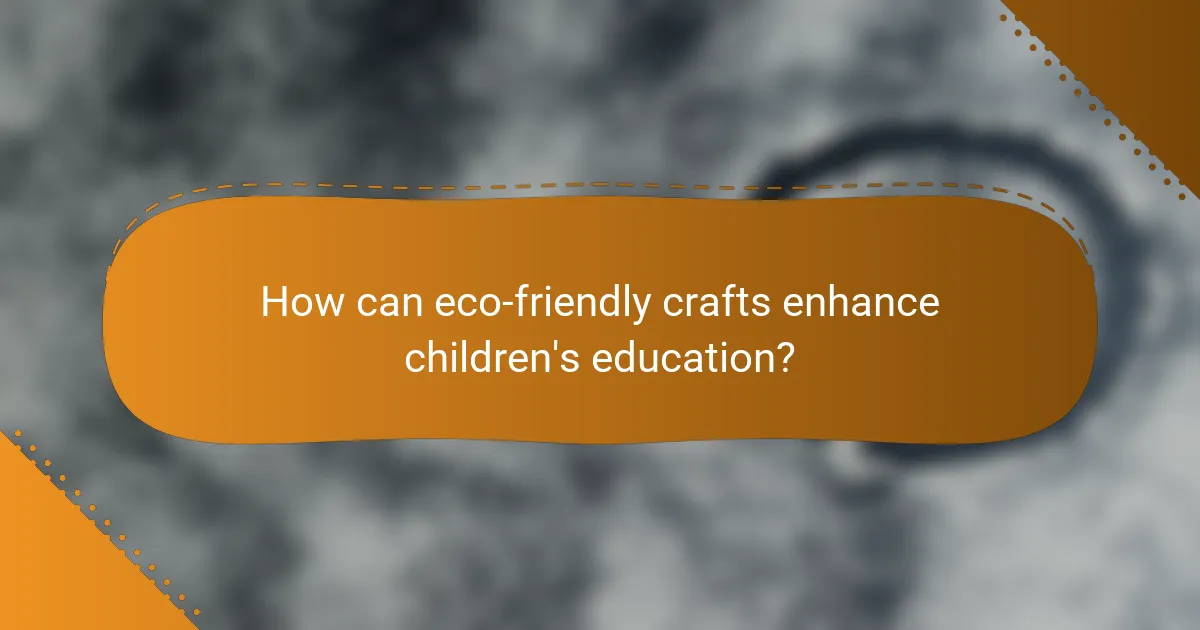
How can eco-friendly crafts enhance children’s education?
Eco-friendly crafts can significantly enhance children’s education by fostering a deeper understanding of sustainability and environmental responsibility. Engaging in these projects not only teaches kids about reusing materials but also encourages them to think critically about their impact on the planet.
Promotes sustainability awareness
Eco-friendly crafts introduce children to the concept of sustainability by using recycled or natural materials. For example, creating art from old newspapers or cardboard boxes helps kids recognize the value of reusing items instead of discarding them. This hands-on experience cultivates a mindset that prioritizes environmental health.
Additionally, discussing the origins of the materials used in their projects can enhance their understanding of resource consumption and waste. Kids learn that their choices can contribute to a healthier planet, reinforcing the importance of sustainable practices in everyday life.
Encourages creativity and problem-solving
Crafting with eco-friendly materials encourages children to think outside the box and come up with innovative solutions. When faced with limited resources, kids must brainstorm creative ways to transform ordinary items into unique projects. This process not only sparks imagination but also develops critical thinking skills.
For instance, using bottle caps to create a mosaic or turning old clothes into tote bags challenges children to envision new uses for discarded items. These activities promote a sense of accomplishment and boost confidence in their creative abilities.
Teaches resourcefulness
Engaging in eco-friendly crafts teaches children the value of resourcefulness by showing them how to make the most of what they have. By utilizing materials that might otherwise be thrown away, kids learn to appreciate the potential in everyday items. This practice encourages them to be mindful of waste in their daily lives.
To reinforce this lesson, parents and educators can encourage kids to gather materials from home or the community for their projects. This not only fosters a sense of ownership but also highlights the importance of collaboration and sharing resources, further embedding the principles of sustainability in their education.

What materials are best for eco-conscious crafting?
Eco-conscious crafting materials prioritize sustainability and safety, making them ideal for kids’ projects. The best options include recycled items, biodegradable adhesives, and non-toxic paints, which help reduce waste and environmental impact.
Recycled paper and cardboard
Recycled paper and cardboard are excellent materials for eco-friendly crafting. They can be sourced from old newspapers, packaging, or scrap paper, providing a creative outlet while minimizing waste. Kids can use these materials to create greeting cards, collages, or even 3D models.
When using recycled paper, consider the thickness and texture, as these factors can affect the final product. Thicker cardboard works well for structural projects, while lighter paper is suitable for detailed work. Always check for any glossy coatings that may not be recyclable.
Biodegradable glues
Biodegradable glues are an essential component of eco-conscious crafting, as they break down naturally without harming the environment. Look for options made from natural ingredients like starch or casein, which are safe for children and effective for various projects.
When selecting biodegradable glue, ensure it meets safety standards for children’s use. Avoid glues with harsh chemicals or strong odors. A simple test is to check for labels indicating non-toxic or eco-friendly certifications.
Non-toxic paints
Non-toxic paints are crucial for safe crafting, especially for kids. These paints are typically water-based and free from harmful solvents, making them safer for both children and the environment. Brands often label their products as non-toxic or eco-friendly, which helps in making informed choices.
When using non-toxic paints, consider the application method. Brush-on paints are great for detailed work, while spray paints can cover larger areas quickly. Always supervise children during painting activities and ensure proper ventilation, even with non-toxic options.
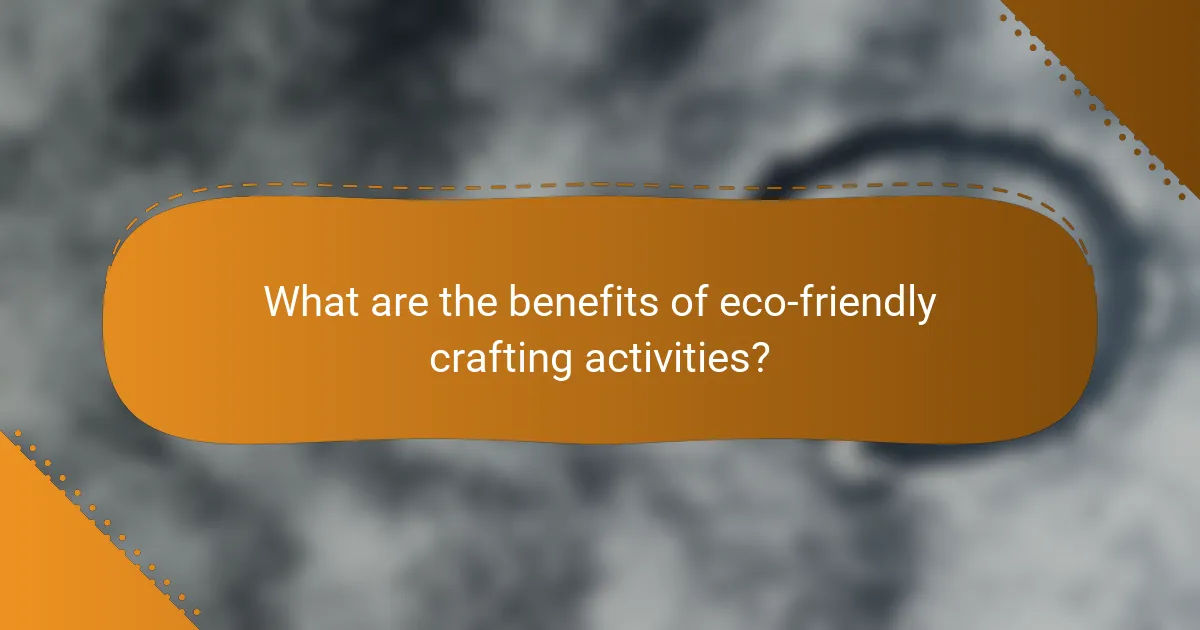
What are the benefits of eco-friendly crafting activities?
Eco-friendly crafting activities provide numerous benefits, including fostering creativity while promoting environmental awareness. These projects not only engage children in fun, hands-on activities but also teach them the importance of sustainability and resourcefulness.
Fosters environmental responsibility
Engaging in eco-friendly crafts helps children understand the impact of their actions on the environment. By using recycled materials and natural resources, kids learn to appreciate the value of sustainability and the importance of reducing waste.
For example, creating art from old newspapers or repurposing glass jars for storage encourages kids to think critically about consumption. This hands-on experience instills a sense of responsibility towards the planet, making them more likely to adopt eco-conscious habits in the future.
Builds fine motor skills
Eco-friendly crafting activities often involve cutting, gluing, and assembling materials, which are excellent for developing fine motor skills. These tasks require precision and coordination, helping children improve their dexterity and hand-eye coordination.
Projects like making greeting cards from recycled paper or constructing bird feeders from pine cones can enhance these skills while keeping the focus on sustainability. Regular practice through crafting can lead to significant improvements in a child’s ability to perform everyday tasks.
Encourages family bonding
Participating in eco-friendly crafting projects can strengthen family ties by providing opportunities for collaboration and shared experiences. Working together on a project fosters communication and teamwork, allowing family members to connect over a common goal.
Activities such as creating a garden using recycled containers or making holiday decorations from natural materials can be enjoyable for all ages. These shared moments not only create lasting memories but also reinforce the importance of caring for the environment as a family unit.
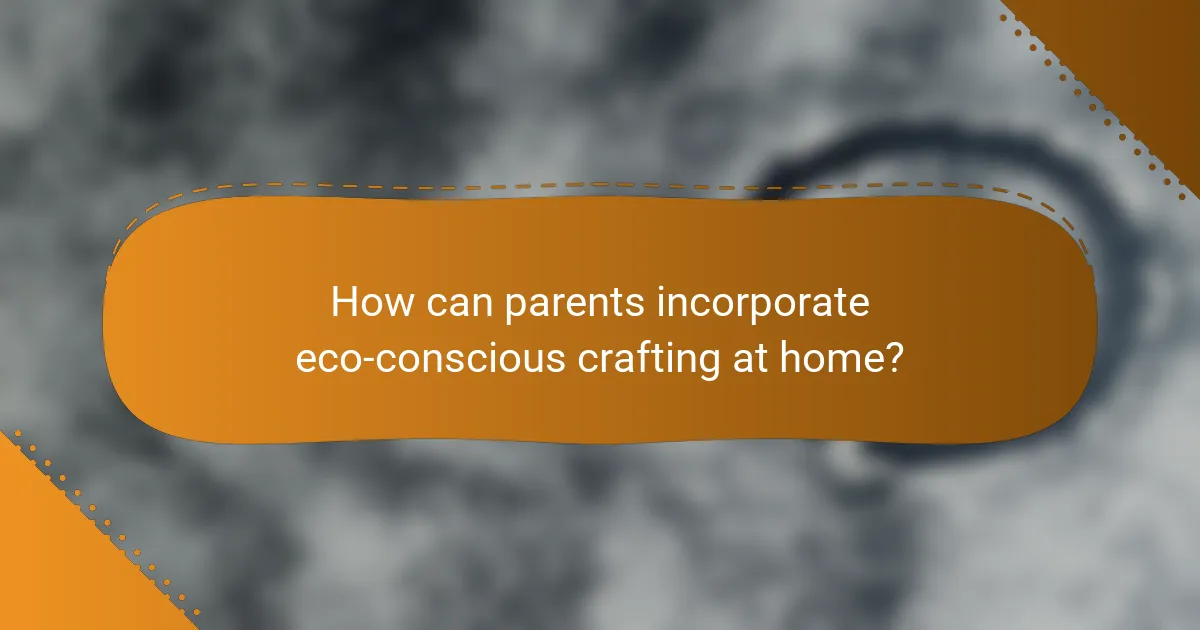
How can parents incorporate eco-conscious crafting at home?
Parents can easily incorporate eco-conscious crafting at home by using sustainable materials and encouraging creativity in their children. This approach not only reduces waste but also fosters an appreciation for the environment through hands-on activities.
Set up a crafting station
Creating a dedicated crafting station at home allows kids to explore their creativity while using eco-friendly materials. Designate a space with easy access to recycled items like cardboard, paper scraps, and natural materials such as leaves or twigs.
Ensure the area is well-organized with containers for different materials, making it simple for children to find what they need. This setup encourages independent crafting and minimizes waste by promoting the use of available resources.
Organize community crafting events
Community crafting events can be a fun way to engage families in eco-conscious activities. Consider organizing a local gathering where participants can bring their recycled materials and create projects together.
These events not only foster community spirit but also provide an opportunity to share ideas and techniques. Collaborating with local schools or community centers can enhance participation and create a larger impact.
Utilize online resources for project ideas
Many online platforms offer a wealth of eco-conscious crafting ideas suitable for children. Websites and social media groups dedicated to sustainable crafting can provide inspiration and step-by-step guides for various projects.
Look for resources that emphasize the use of recycled or natural materials, ensuring that the projects align with eco-friendly principles. Bookmarking a few favorite sites can help parents quickly find new ideas to keep crafting fresh and exciting.
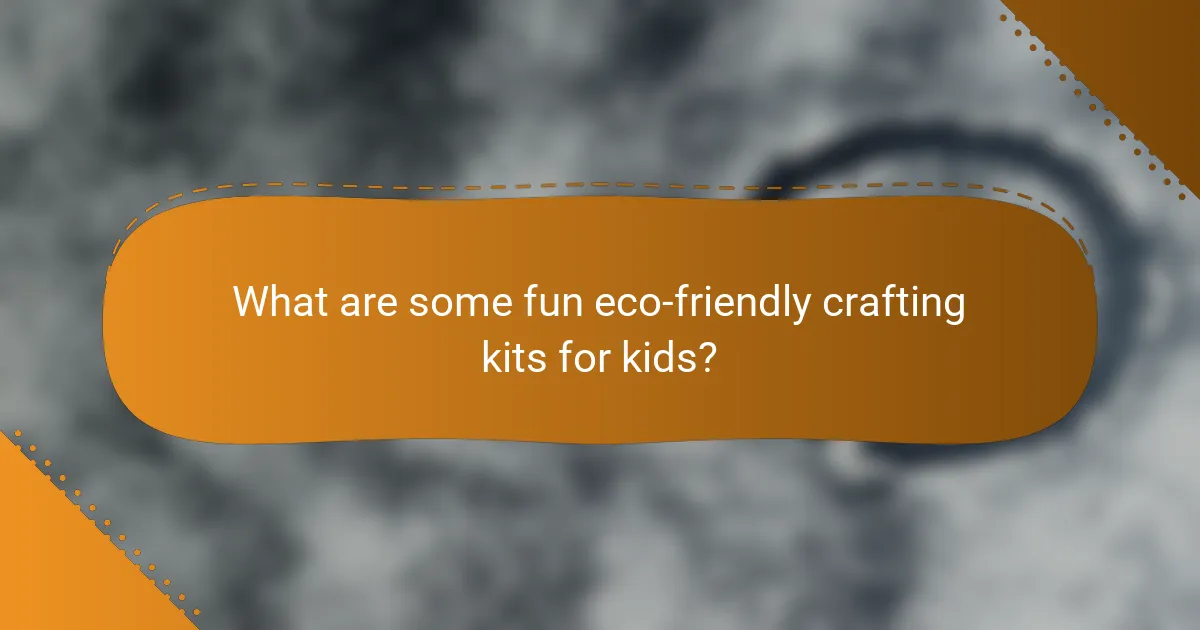
What are some fun eco-friendly crafting kits for kids?
Eco-friendly crafting kits for kids provide engaging, hands-on activities that promote sustainability while sparking creativity. These kits often include natural materials and recyclable components, making them a great choice for environmentally conscious families.
Green Kid Crafts subscription box
Green Kid Crafts offers a monthly subscription box filled with eco-friendly crafting projects designed for children aged 2 to 10. Each box contains materials and instructions for several projects that encourage creativity and learning about nature.
When considering a subscription, note that each box typically features a theme, such as “ocean exploration” or “garden adventures.” This thematic approach not only keeps kids engaged but also introduces them to various environmental concepts.
Parents should look for options that include biodegradable or recyclable materials, ensuring that the crafting experience aligns with eco-conscious values. Additionally, check for any age recommendations to ensure the projects are suitable for your child’s skill level.
